La Cueva de Nerja
Cave of Nerja
Useful Information
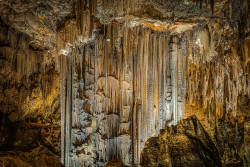

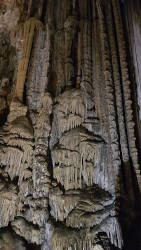
| Location: |
At Nerja.
Ctra. N-340. 4 km from Nerja, 45 km from Málaga. Autovía del Mediterráneo A-7 (Mediterranean Highway), exit 295 Cueva de Nerja. |
| Open: |
JAN to JUN daily 9:30-16:30, last entry 15:30. JUL to AUG daily 9:30-18, last entry 17. SEP to DEC daily 9:30-16:30, last entry 15:30. Closed 01-JAN, 15-MAY. [2020] |
| Fee: |
Adults EUR 13, Children (6-12) EUR 11, Children (0-5) free. Online: Adults EUR 11.75, Children (6-12) EUR 9.75, Children (0-5) free. Seasonal Surcharge: MAY to JUN EUR 1, JUL to SEP EUR 2, OCT EUR 1. [2020] |
| Classification: |
 Karst Cave Karst Cave
|
| Light: |
 Electric Light Electric Light
|
| Dimension: | L=4,823 m, VR=70 m, A=158 m, T=20 °C, H=82%. |
| Guided tours: |
D=45 min, L=1,450 m, St=400. audio guides available in 15 languages:  , ,
 , ,
 , ,
 , ,
 , ,
 , ,
 , ,
 , ,
 , ,
 , ,
 , ,
 , ,
 , ,
 , ,
 . .
Guided tours after appointment for groups. Cave Trekking tours: D=7 h. V=500,000/a [2000] |
| Photography: | allowed, no flash, no tripods, no selfie sticks, no laser pointers or flashlights. |
| Accessibility: | no |
| Bibliography: |
Juan José Valsero, Francisco Carrasco (1994):
Cueva de Nerja,
guidebook


Horacio Eichelbaum et al (1994): Cueva de Nerja, 
Manuel Pellicer Catalan (1995): Tras la Identidad de la Arqueologia, Patronato de la Cueva de Nerja, ISBN-10: 8492026820, ISBN-13: 978-8492026821 
|
| Address: |
Fundación Pública de Servicios Cueva de Nerja, Carretera de Maro s/n, 29787, Nerja, Málaga, Tel: +34-95-2529520, Fax: +34-95-2529646,
E-mail: |
| As far as we know this information was accurate when it was published (see years in brackets), but may have changed since then. Please check rates and details directly with the companies in question if you need more recent info. |
|
History
| 12-JAN-1959 | discovered. |
| 1960 | artificial entrance, opened to the public. |
| 15-JUN-1961 | declared an Artistic Historical Monument. |
| 1969/70 | new part discovered: Galerías Altas y Nuevas, the upper and new galleries. |
| 1999 | Cueva de Nerja Research Institute (IICN) created. |
| 2006 | declared an Asset of Cultural Interest. |
| 12-JAN-2009 | 50 years of the discovery celebrated. |
| FEB-2012 | Neanderthal cave paintings discovered. |
Description
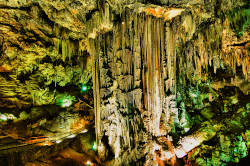
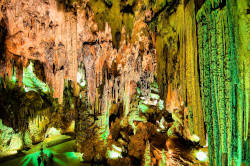
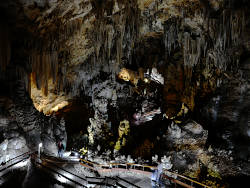
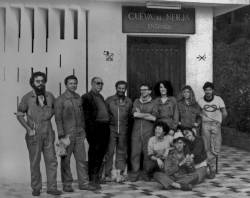
La Cueva de Nerja (Cave of Nerja) is simply named after the nearby town Nerja. The Spanish name is pronounced Nerkha. One theory explains this name is derived from Narixa which means abundant spring.
The cave of Nerja is a famous archaeological site with 40,000 year old remains. But the paleolithic paintings cannot be visited. For a good description see the text by Tony Oldham below.
A recent addition to the regular tourist tours are cave trekking tours. They take seven hours in total and cost EUR 90 per person. Between October and May groups of 10 visitors get the chance to see the upper galleries of the cave called Galerías Altas y Nuevas (High and New Galleries). The chambers Columnas de Hércules (Hercules’Pillars), Inmensidad (Inmensity), La Galería de los Niveles (Levels Gallery) and La Sala de la Lanza (Lance Room) are visited. The day starts with a breakfast at Cueva de Nerja restaurant. Then the visitors are introduced by cave guides, change into the provided caving gear and enter the cave. The underground tour takes five hours, the visitors get an isotonic drink and energy bars. After the tour there is a possibility to shower and clean the caving gear. The visitors receive a T-shirt to commemorate the visit.
The cave claims a superlative, they say they have the largest stalagnate or column in the world, and proof it by the claim to be listed in the Guiness Book of World Records (1994 edition). Actually we do not know if this is true, and while we maintain a list of largest stalagmites, and a list of largest stalactites, we do not have a list of largest stalagnates. The speleothem is pretty impressive, located in the Sala del Cataclismo (Hall of Cataclysm) it has a height of 32 m and a width of 7 m by 13 m. However, there is no way to find out if this claim is true, but actually there are stalagmite which are more than twice as high, so we tend not to believe this. On the other side, we find that the speleothem is well worth a visit, no matter if it actually is the largest column or not.
On our internet research we found a rather funny thing about this largest column superlative. There are numerous articles on the web concerning this cave. Many of them cite the superlative claim. Funny is, that none of them was able to understand it, so none tells about the largest column. Most say it’s the largest stalagmite, a few even say it’s the largest stalactite.
In February 2012 cave paintings were discovered, which have been dated to 42,000 years old. This makes them the earliest human paintings ever found. And as there is no evidence of modern humans in the area at this time, the paintings were most likely created by Neanderthals. This is exceptional, as prehistoric artworks are generally thought to be made by Homo sapiens because Neanderthals were believed to be incapable of creating art. The red drawings of stalactites look like a DNA double helix. Archaeologists interpret them as pictures of seals, which were a food source for neanderthals in Malaga.
- See also
 Cueva de Nerja by Tony Oldham (2000).
Cueva de Nerja by Tony Oldham (2000). Bibliography for the Cueva de Nerja by Tony Oldham (2000).
Bibliography for the Cueva de Nerja by Tony Oldham (2000). Caves With The Tallest Stalagmite
Caves With The Tallest Stalagmite Guiness World (Cave) Records
Guiness World (Cave) Records Member of the International Show Caves Association (ISCA)
Member of the International Show Caves Association (ISCA) Search DuckDuckGo for "Cueva de Nerja"
Search DuckDuckGo for "Cueva de Nerja" Google Earth Placemark
Google Earth Placemark Caves of Nerja - Wikipedia (visited: 11-MAR-2012)
Caves of Nerja - Wikipedia (visited: 11-MAR-2012) Fundación Cueva de Nerja, official website
Fundación Cueva de Nerja, official website 
 (visited: 20-OCT-2011)
(visited: 20-OCT-2011) My Nerja Cave guide on the Andalucia Costa del Sol, Nerja, Spain (visited: 19-OCT-2011)
My Nerja Cave guide on the Andalucia Costa del Sol, Nerja, Spain (visited: 19-OCT-2011)
 Index
Index Topics
Topics Hierarchical
Hierarchical Countries
Countries Maps
Maps